What if your data visualizations looked like scenes from your favorite movies? That’s exactly what I set out to create with the Cinestyle library - a Python package that transforms standard matplotlib charts into cinematic masterpieces.
Using 50,000 IMDB movie reviews, I’ll show you how to create five stunning visualizations, each inspired by iconic films and directors: Film Noir, Studio Ghibli, Wes Anderson, Blade Runner, and Star Wars.
GitHub Repository: cinematic-matplotlib
The Dataset
For this project, I analyzed 50,000 IMDB movie reviews with sentiment labels (positive/negative). The dataset is perfectly balanced:
- 25,000 positive reviews (50%)
- 25,000 negative reviews (50%)
- Average review length: 1,309 characters
- Average word count: 231 words per review
Interesting insight: Negative reviews use “movie” (34,811 occurrences) more frequently than positive reviews (26,681), while positive reviews use “film” (29,367) more than negative reviews (25,719).
Five Cinematic Styles
1. Film Noir - Sentiment Distribution
Film Noir is all about high contrast, dramatic shadows, and bold reds against deep blacks. Perfect for emphasizing stark differences in your data.
import pandas as pd
import matplotlib.pyplot as plt
from cinestyle import FilmNoir
# Load data
df = pd.read_csv('IMDB Dataset.csv')
# Initialize Film Noir style
noir = FilmNoir()
fig, ax = plt.subplots(figsize=(12, 8))
noir.style_axes(ax)
# Create bar chart
sentiments = df['sentiment'].value_counts()
bars = ax.bar(sentiments.index, sentiments.values,
color=['#8B0000', '#FFFFFF'],
edgecolor='white', linewidth=2, width=0.6)
ax.set_title("LIGHT VS DARK: SENTIMENT DISTRIBUTION",
color='white', fontsize=22, fontweight='bold', pad=20)
ax.set_ylabel('Review Count', color='white', fontsize=14)
# Add value labels
for bar in bars:
height = bar.get_height()
ax.text(bar.get_x() + bar.get_width()/2., height,
f'{int(height):,}',
ha='center', va='bottom', color='white',
fontsize=16, fontweight='bold')
plt.savefig('noir_sentiment.png', dpi=300, bbox_inches='tight',
facecolor='#121212')
plt.show()
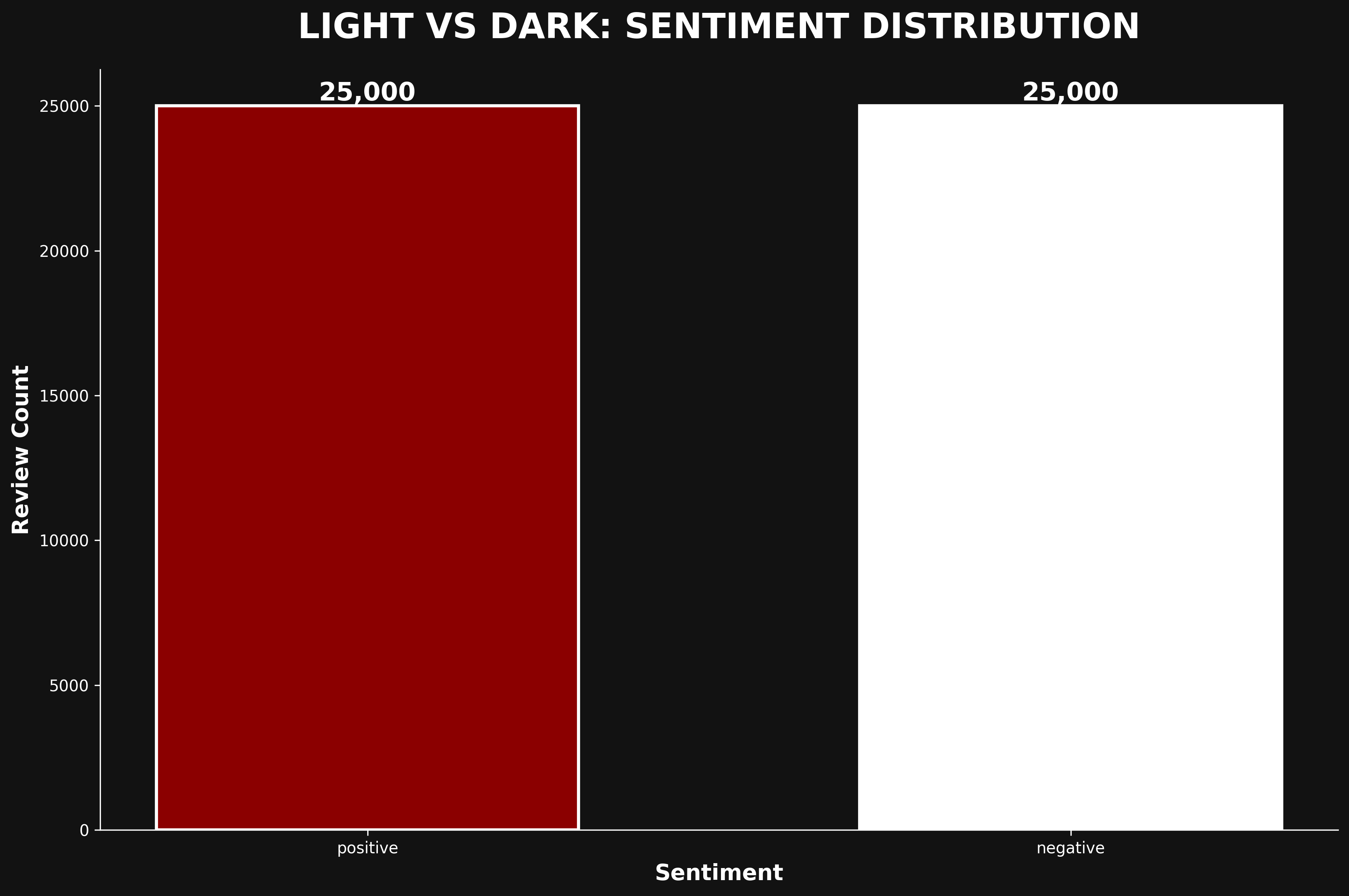
When to use: Dramatic comparisons, binary classifications, emphasizing stark contrasts in data.
2. Studio Ghibli - Review Length Distribution
Inspired by the soft pastoral greens and flowing landscapes of Studio Ghibli films, this style creates calming, approachable visualizations.
from cinestyle import Ghibli
# Calculate review lengths
df['review_length'] = df['review'].str.len()
# Initialize Ghibli style
ghibli = Ghibli()
fig, ax = plt.subplots(figsize=(14, 8))
ghibli.style_axes(ax)
# Create histogram
ax.hist(df['review_length'], bins=60, color='#90EE90',
alpha=0.7, edgecolor='#2F4F2F', linewidth=1.5)
ax.set_title("The Flow of Words: Review Length Distribution",
fontsize=20, pad=20, fontweight='600')
ax.set_xlabel('Character Count', fontsize=14)
ax.set_ylabel('Number of Reviews', fontsize=14)
# Add mean line
mean_length = df['review_length'].mean()
ax.axvline(mean_length, color='#8B4513', linestyle='--',
linewidth=2.5, label=f'Mean: {mean_length:.0f} characters')
ax.legend(fontsize=12)
plt.savefig('ghibli_length.png', dpi=300, bbox_inches='tight')
plt.show()
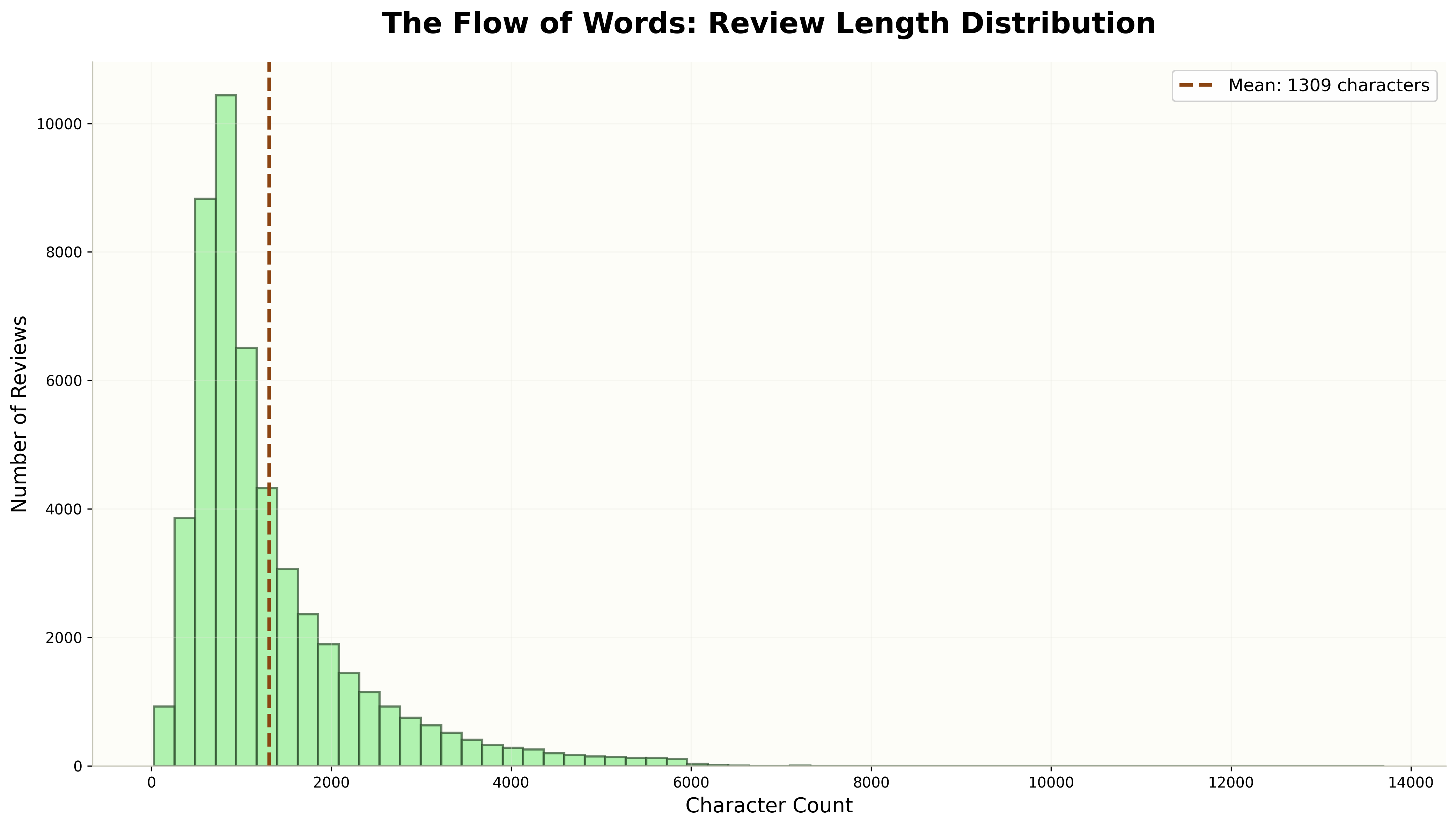
Data insight: Reviews have a median length of 970 characters, with a range from 32 to 13,704 characters.
When to use: Distributions, frequency analyses, or any data that benefits from a calming, approachable aesthetic.
3. Wes Anderson - Word Frequency Comparison
Wes Anderson films are known for their perfect symmetry and carefully curated pastel palettes. This style is ideal for balanced comparisons.
from cinestyle import WesAnderson
from collections import Counter
# Get top words by sentiment
def get_top_words(reviews, n=10):
words = ' '.join(reviews).lower().split()
stopwords = {'the', 'a', 'an', 'and', 'or', 'but', 'in', 'on',
'at', 'to', 'for', 'of', 'is', 'it', 'this', 'that'}
words = [w for w in words if w not in stopwords and len(w) > 3]
return Counter(words).most_common(n)
pos_words = get_top_words(df[df['sentiment']=='positive']['review'])
neg_words = get_top_words(df[df['sentiment']=='negative']['review'])
# Initialize Wes Anderson style
wes = WesAnderson()
fig, (ax1, ax2) = plt.subplots(1, 2, figsize=(18, 8))
wes.style_axes(ax1)
wes.style_axes(ax2)
# Positive words panel
pos_labels = [w[0] for w in pos_words]
pos_values = [w[1] for w in pos_words]
ax1.barh(pos_labels, pos_values, color='#F4A460',
edgecolor='#8B4513', linewidth=1.5)
ax1.set_title("Positive Words", fontsize=18, fontweight='600')
ax1.invert_yaxis()
# Negative words panel
neg_labels = [w[0] for w in neg_words]
neg_values = [w[1] for w in neg_words]
ax2.barh(neg_labels, neg_values, color='#9370DB',
edgecolor='#4B0082', linewidth=1.5)
ax2.set_title("Negative Words", fontsize=18, fontweight='600')
ax2.invert_yaxis()
fig.suptitle('A Symmetrical Study of Sentiment',
fontsize=22, fontweight='bold', y=0.98)
plt.savefig('wes_anderson_words.png', dpi=300, bbox_inches='tight')
plt.show()
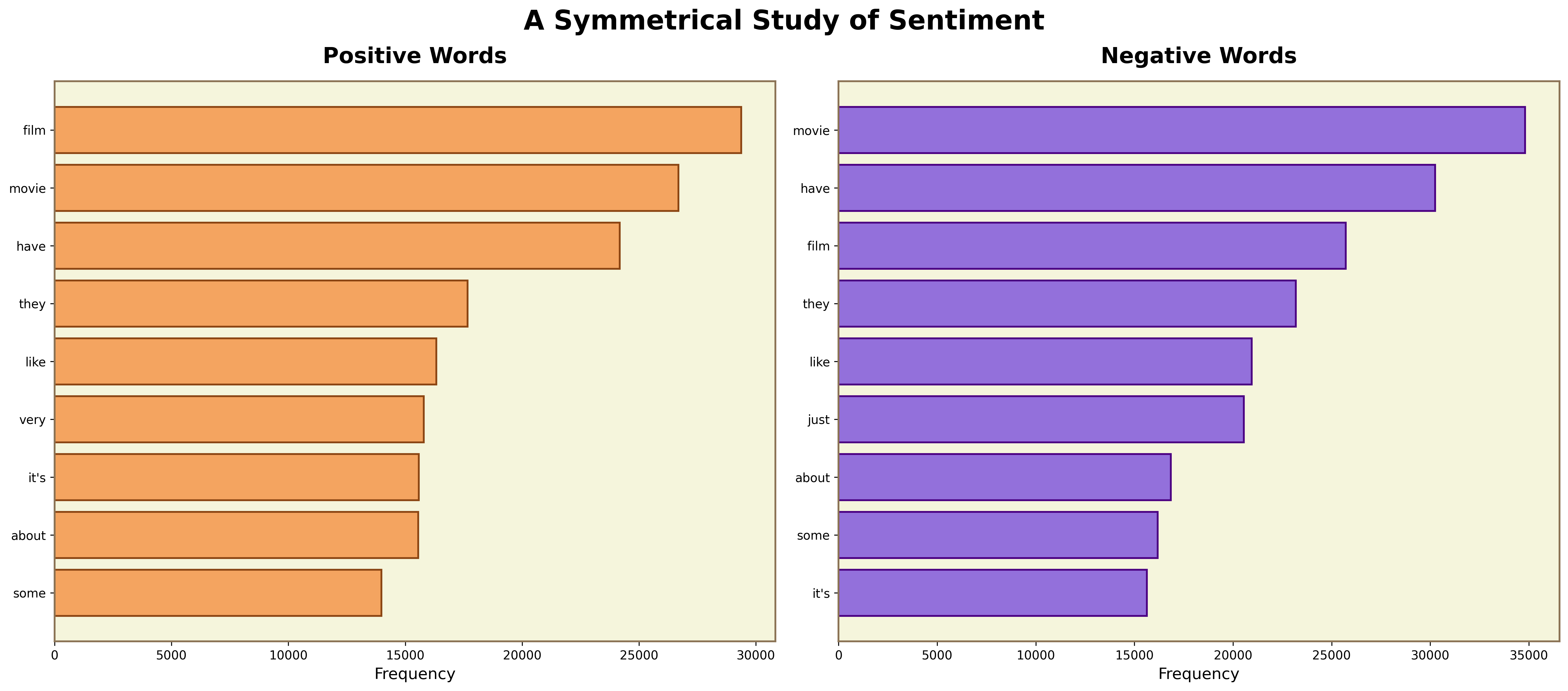
Data insight: Top words overlap between sentiments. Negative reviews: “movie” (34,811), “just” (20,544). Positive reviews: “film” (29,367), “very” (15,791).
When to use: Side-by-side comparisons, categorical data, or when you want to emphasize symmetry and careful composition.
4. Blade Runner - Word Count Scatter Plot
Cyberpunk aesthetics meet data visualization with neon cyan and magenta on a dark background - perfect for modern, tech-focused presentations.
from cinestyle import BladeRunner
# Calculate word counts
df['word_count'] = df['review'].str.split().str.len()
# Initialize Blade Runner style
blade = BladeRunner()
fig, ax = plt.subplots(figsize=(12, 8))
blade.style_axes(ax)
# Sample for performance
positive = df[df['sentiment']=='positive'].sample(2000, random_state=42)
negative = df[df['sentiment']=='negative'].sample(2000, random_state=42)
# Create scatter plot
ax.scatter(positive.index, positive['word_count'],
c='#00FFFF', alpha=0.5, s=20, label='Positive')
ax.scatter(negative.index, negative['word_count'],
c='#FF00FF', alpha=0.5, s=20, label='Negative')
ax.set_title("WORD COUNT PATTERNS", color='cyan',
fontsize=20, fontweight='bold')
ax.set_xlabel('Review Index', color='cyan')
ax.set_ylabel('Word Count', color='cyan')
ax.legend(facecolor='#0a0a0a', edgecolor='#00FFFF')
plt.savefig('blade_runner_scatter.png', dpi=300, bbox_inches='tight',
facecolor='#0a0a0a')
plt.show()
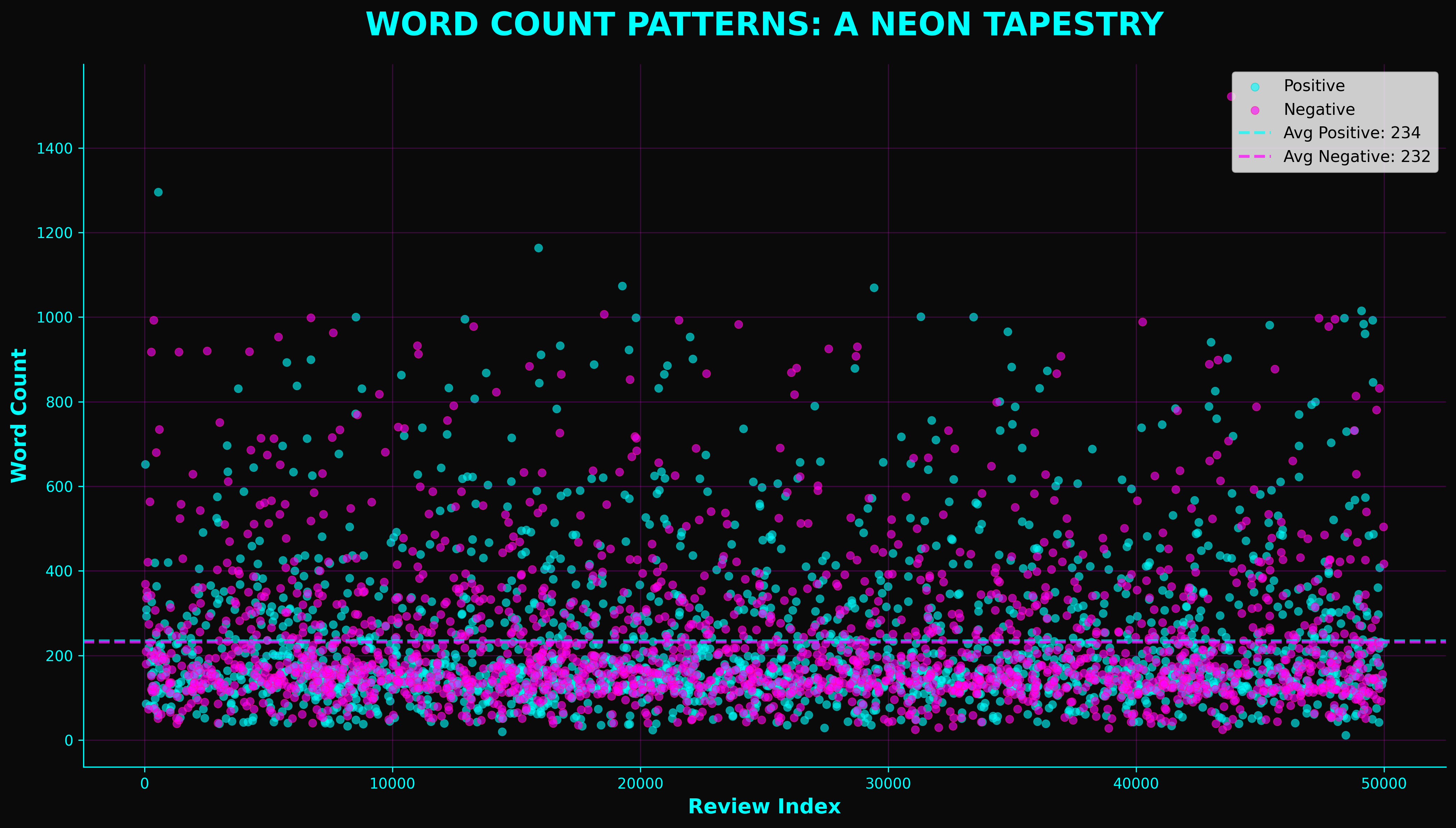
Data insight: Reviews average 233 words (positive) vs 229 words (negative). Median word count is 173 words across all reviews.
When to use: Modern/tech presentations, scatter plots, or when you want a futuristic, edgy aesthetic.
5. Star Wars - Epic Keyword Universe
Bold gold and blue on pure black - when your data deserves an epic, larger-than-life presentation.
from cinestyle import StarWars
# Get top 20 keywords across all reviews
all_words = get_top_words(df['review'], n=20)
# Initialize Star Wars style
starwars = StarWars()
fig, ax = plt.subplots(figsize=(14, 8))
starwars.style_axes(ax)
# Create horizontal bar chart
words = [w[0] for w in all_words]
counts = [w[1] for w in all_words]
colors = ['#FFD700', '#1E90FF'] * 10
ax.barh(words, counts, color=colors, edgecolor='#FFD700', linewidth=1.5)
ax.set_title("EPIC KEYWORD UNIVERSE", color='gold',
fontsize=22, fontweight='bold')
ax.set_xlabel('Frequency', color='gold', fontsize=14)
ax.invert_yaxis()
# Add value labels
for i, (word, count) in enumerate(all_words):
ax.text(count, i, f' {count:,}', va='center',
color='gold', fontsize=11, fontweight='bold')
plt.savefig('star_wars_keywords.png', dpi=300, bbox_inches='tight',
facecolor='black')
plt.show()
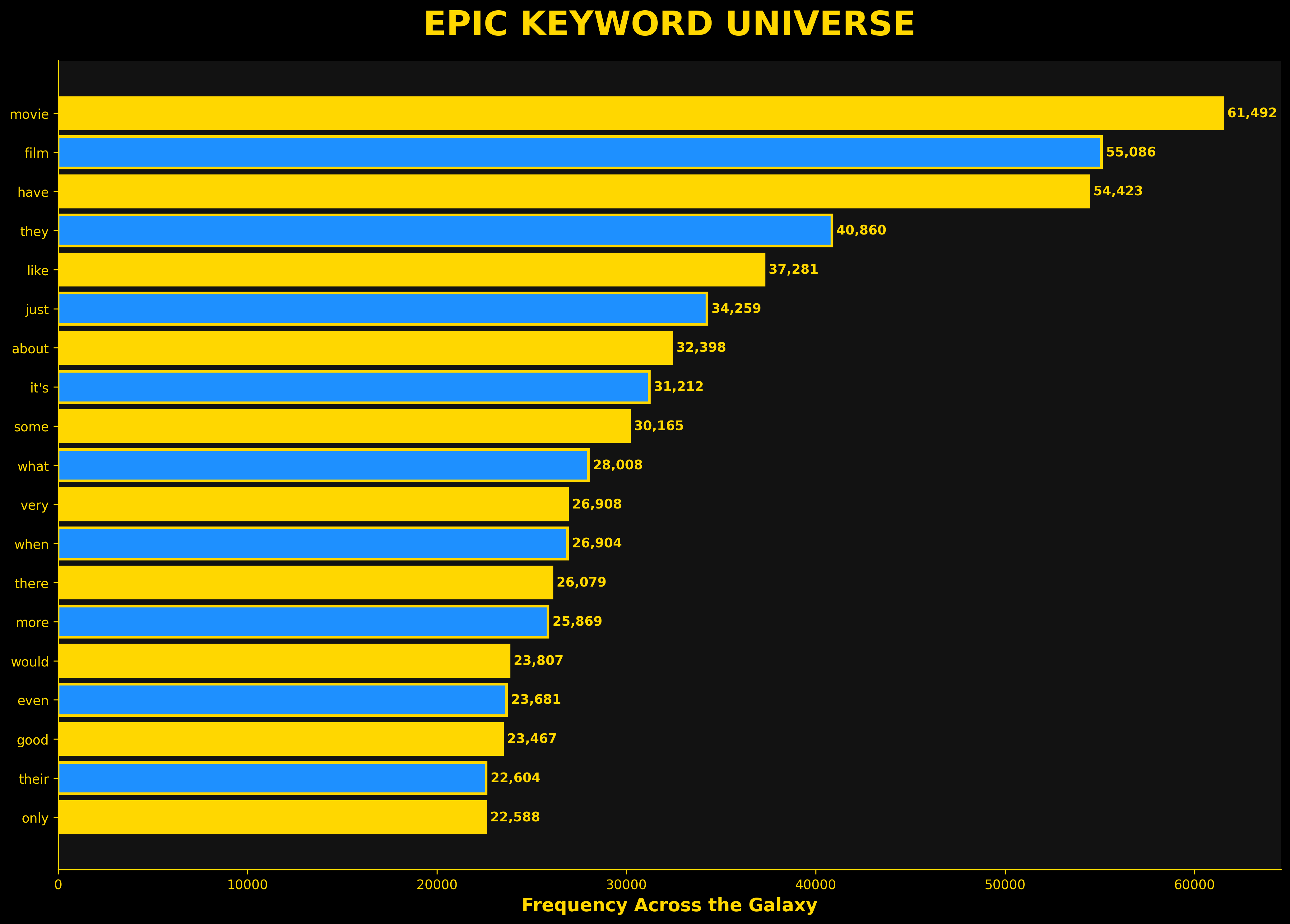
Data insight: Top words across all reviews are “movie” (61,492), “film” (55,086), “have” (54,423), “they” (40,860), and “like” (37,281).
When to use: Important metrics, ranking data, or any visualization that deserves bold, dramatic presentation.
Installation & Getting Started
Install the Cinestyle Library
# Clone the repository
git clone https://github.com/Burton-David/cinematic-matplotlib.git
# Navigate to the directory
cd cinematic-matplotlib
# Install the package
pip install -e .
Basic Usage
import matplotlib.pyplot as plt
from cinestyle import FilmNoir, Ghibli, WesAnderson, BladeRunner, StarWars
# Choose your style
noir = FilmNoir()
fig, ax = plt.subplots(figsize=(12, 8))
noir.style_axes(ax)
# Create your plot as usual
ax.plot([1, 2, 3], [4, 5, 6])
plt.show()
Quick Reference: When to Use Each Style
| Style | Best For | Visual Characteristics |
|---|
| Film Noir | Dramatic comparisons, binary data, stark contrasts | High contrast, dark background, bold reds and whites |
| Studio Ghibli | Distributions, flowing data, calming presentations | Soft greens, pastoral palette, organic curves |
| Wes Anderson | Side-by-side comparisons, symmetrical layouts | Perfect symmetry, pastel colors, balanced composition |
| Blade Runner | Tech/modern presentations, scatter plots | Neon cyan/magenta, cyberpunk aesthetic, dark background |
| Star Wars | Important metrics, rankings, bold statements | Gold and blue, epic scale, dramatic typography |
Under the Hood
The Cinestyle library works by customizing matplotlib’s rcParams and providing convenient wrapper classes. Each style:
- Sets figure and axes background colors
- Customizes font families and weights
- Defines color palettes inspired by the films
- Provides style-specific plotting methods
- Includes common methods for all standard chart types
You can combine Cinestyle with standard matplotlib commands for complete customization:
noir = FilmNoir()
fig, ax = plt.subplots()
noir.apply_style() # Apply rcParams
noir.style_axes(ax) # Style the axes
# Then use any matplotlib functions
ax.plot(x, y, color=noir.colors['primary'])
Conclusion
Data visualization doesn’t have to be boring. By drawing inspiration from cinematic aesthetics, you can create charts that are not only informative but also visually stunning and memorable.
The Cinestyle library makes it easy to apply these professional, film-inspired styles to your data with just a few lines of code. Whether you’re creating dashboards, research papers, or blog posts, these styles will help your visualizations stand out.
Try it yourself:
- Explore the GitHub repository
- Check out the example notebooks
- Create your own cinematic visualizations
- Contribute new styles (Tarantino? Kubrick?)
Transform your next data visualization into a cinematic masterpiece. Your data deserves to look this good.
All code examples and visualizations are available in the cinematic-matplotlib GitHub repository.